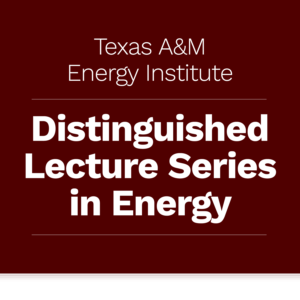
Leveraging AI and Large Language Models to Navigate the Water-Energy-Food-Health Nexus
The Texas A&M Energy Institute’s Distinguished Lecture Series in Energy will feature Dr. Ilya Zaslavsky, the Director of Spatial Information Systems Laboratory at the University of California San Diego, on Wednesday, November 13, 2024, from 11:00 a.m. – 12:00 p.m. CST (UTC -6:00) in the Frederick E. Giesecke Engineering Research Building (GERB) Third Floor Conference Room and through a Zoom Meeting. The topic will be “Leveraging AI and Large Language Models to Navigate the Water-Energy-Food-Health Nexus.”
Abstract
Large language models (LLMs) are creating new opportunities for exploring the complex Water-Energy-Food-Health (WEFH) Nexus by extracting insights from diverse interdisciplinary sources such as scientific articles, policy documents, and environmental and health datasets. This presentation will showcase findings from several projects that tested LLM approaches for addressing WEFH challenges. We’ll also demonstrate an emerging software ecosystem built on open-source components, designed to support integrated data analysis and decision-making across WEFH domains.
One example is the NIH-funded Global Center on Climate Change, Water, Energy, Food, and Health Systems (GC3WEFH), a multi-institution, international project focused on modeling climate impacts on vulnerable communities in water-scarce regions of Jordan. Working with researchers at Texas A&M University and other partners, we explore how climate change affects health, food security, water quality and quantity, and water and energy use. GC3WEFH’s data hub offers an innovative data catalog that allows users to perform LLM-assisted natural language queries, enabling data access, visualizations, and predictive analytics for modeling environmental and health impacts.
A related NSF-funded project, the WEN-OKN (Water-Energy Nexus Open Knowledge Network), is building an LLM-driven network for data integration across water and energy datasets. Using LLMs combined with structured knowledge graphs, WEN-OKN enables federated queries across knowledge graphs and other sources such as the Urban Flooding Open Knowledge Network, Internet of Water, U.S. Energy Atlas, KnowWhereGraph, and Data Commons, to answer complex questions about water supply, flooding, energy demand, and water and energy infrastructure risks. These projects demonstrate the potential of an AI-driven, open-source ecosystem to deliver actionable insights and enhance decision-making across the WEFH Nexus.
Biography
Ilya Zaslavsky is the Director of the Spatial Information Systems Laboratory at the San Diego Supercomputer Center, University of California, San Diego. His research focuses on distributed information management systems, particularly spatial and temporal data integration, geographic information systems, and spatial and survey data analysis. Ilya earned his Ph.D. from the University of Washington in 1995, specializing in statistical analysis and reasoning models for geographic data. He also holds a Ph.D. equivalent from the Russian Academy of Sciences, Institute of Geography, for his work on urban simulation modeling and metropolitan evolution, completed in 1990. As a technical design and development lead, he has contributed to several cyberinfrastructure projects, including the CUAHSI Hydrologic Information System, WIFIRE, and the EarthCube Data Discovery Studio.
Dr. Zaslavsky has led international research and collaboration efforts in several fields, serving as co-chair of the OGC/WMO Hydrology Domain Working Group (2008-2018), an international group of experts developing standards for water data exchange adopted around the world, and as co-chair of the Global Water Information Interest Group of the Research Data Alliance (from 2019). Zaslavsky has been an invited speaker at prominent national and international venues such as the Library of Congress, Rio+20, and the Kyoto Forum. He has received research support from the U.S. National Science Foundation, the National Institutes of Health, the U.S. Department of State, the U.S. Geological Survey, Microsoft, ESRI, and other organizations.
